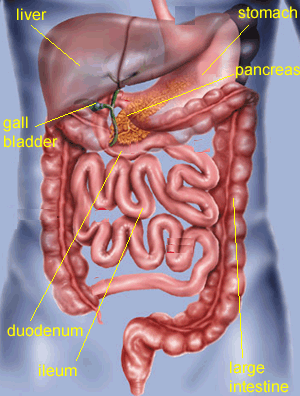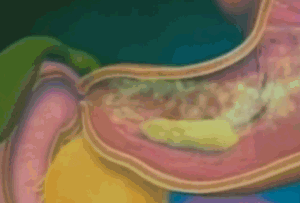The digestive system is made up of many organs which together have the role of physically and chemically breaking down food into smaller molecules that are able to pass from the intestinal wall into the blood.
Digestion is the process of food breakdown. This process starts in the mouth where food is broken down physically by chewing and chemically by the action of enzymes, in particular amylase.

In the mouth food is chewed in order to increase its surface area and mixed with saliva.
An enzyme known as amylase which is found in the saliva starts the process of chemical digestion by breaking down starch into maltose.

Food travels from the mouth down a muscular tube called the oesophagus into the stomach. The action of swallowing closes the wind pipe so food can pass down the oesophagus. Food is pushed along the oesophagus by muscular contractions known as peristalsis.
The stomach is a muscular sac-like organ that cherns the food and mixes it with chemicals such as hydrochloric acid and enzymes such as pepsin that begin the chemical breakdown of large molecules called proteins.

After a while the stomach empties its contents into the duodenum where the semi-digested food is mixed with bile from the gall bladder and enzymes from the pancreas such as proteases which breakdown proteins into amino acids and lipases which breakdown fats. The pancreas also produces chemicals that neutralise the stomach acid and other enzymes that continue the breakdown of starch, although the digestion of starch starts in the mouth.
Bile serves to emulsify the fat reducing the physical size of the fat particles and making it easier for enzymes to chemically break it down.
Mucus is a very important substance in the digestive tract. It serves to lubricate the passage of food and protect the stomach and intestinal wall from the harsh chemicals involved in digestion. Stomach ulcers can occur when not enough mucus is produced to protect the wall of the stomach from the acid and proteases.
